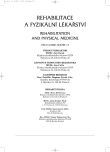Modification of the Effects of Acupuncture by Positioning in Cerebral Palsy
Authors:
I. Poláchová 1; L. Kratochvílová 1; M. Mayer 1,2
Authors‘ workplace:
Katedra fyzioterapie, Fakulta tělesné kultury, Olomouc
vedoucí prof. MUDr. J. Opavský, CSc.
1; Pracoviště fyziatrie a léčebné rehabilitace, železniční poliklinika, Olomouc
ředitel Ing. B. Kolář, MBA
2
Published in:
Rehabil. fyz. Lék., 13, 2006, No. 4, pp. 177-184.
Category:
Original Papers
Overview
In children with cerebral palsy (CP) the authors investigated the effect of a single acupressure treatment with positioning oriented to postural third month pattern or higher patterns. The effects on spasticity, quality of walking and grip, inter-condyles distance and change in the time of walking were evaluated in 25 children with CP. In a time lapse of at least 24hours every child went through a single acupressure treatment, single acupressure treatment with positioning and a single testing without acupressure treatment. The treatment included pressure at 6 acupressure points on each side. The evaluation of spasticity by means of the modified Ashworth scale for upper and lower extremities was made before and after the treatment and in a corresponding time lapse without treatment in the control group and the evaluation of walking quality was made by the Scale of visual evaluation of walking for blind and non-blind evaluation, the evaluation of the time of walking, evaluation of the function of hand and quality of grip by means of the Scale for visual evaluation of functional task of hand and measurement of inter-condyles distance. The statistical evaluation employed non-parametric statistical tests of Kruskal-Wallis, Duncan and Wilcoxon. The results indicate that a single treatment of acupressure resulted in significant improvement in most tests used compared with the control group (without treatment). The improvement in children treated by the combined procedure – acupressure with positioning – proved to be more evident against the control group in most parameters as compared with the group treated with acupressure only, although the difference for the single treatment did not reach the level of statistical significance. The method can be recommended as a possible variant in the complex approach in the therapy of children with CP. A further investigation will require the effect of repeated treatment by the described procedure.
Key words:
cerebral palsy, acupressure, positioning, development, third month pattern
Labels
Physiotherapist, university degree Rehabilitation Sports medicineArticle was published in
Rehabilitation and Physical Medicine

2006 Issue 4
Most read in this issue
- Vertebrogenic Complaints and Stabilizing Function of Muscles – Diagnostics
- The Role of Diastasis Recti Abdominis in Genesis of Low Back Pain
- Pain as a Factor Indicating and Limiting Rehabilitation
- Muscle Dysbalance of Cervical Muscles
